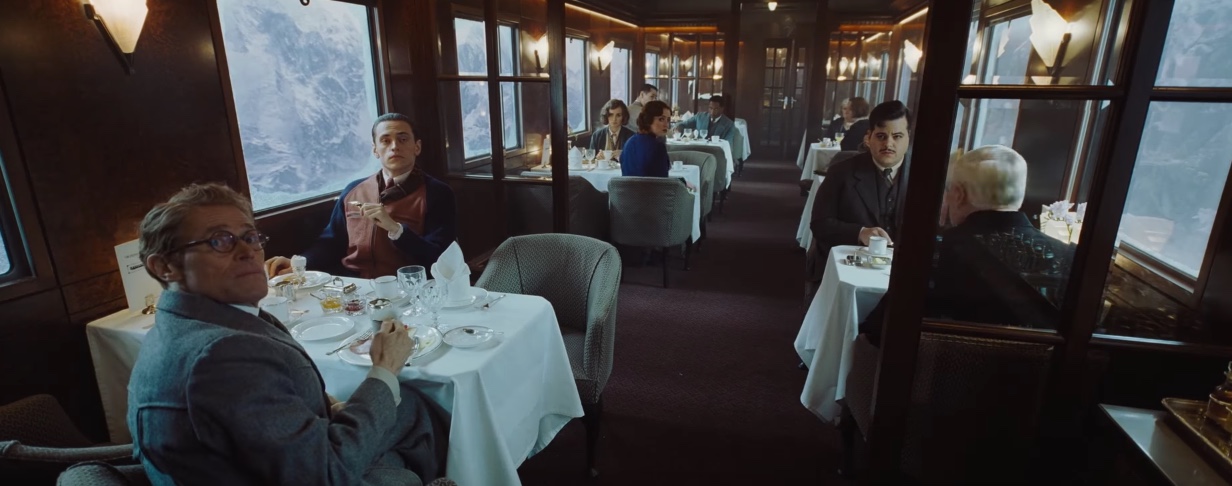I’ve always thought screenwriters have it easy when writing descriptions. Creating a vivid setting in a movie is much quicker than on the page. On the screen, a ten-second pan of the camera gives the viewer everything she needs to know. This would take pages and pages to set up in a novel.
Or would it?

Murder on the Orient Express: The scene is set with one image.
Writing vivid description is not about being clever with adjectives or developing lovely metaphors. Writing vivid description is about curating the essential elements for the reader. In other words, it is not about expanding; it is about narrowing. Narrow the reader’s focus on what matters most and the place or the object comes alive.
It is so tempting to imagine the location of your story—whether it is Los Angeles or Middle Earth or the Orient Express—and run down every item like a laundry list. This is the literary equivalent of the annoying co-worker who adds the high-priority red exclamation point to every email he sends. If everything is high priority, then nothing is. The same is true for your descriptions. When everything is given equal importance, nothing stands out in the reader’s mind.
Blah-Blah Passages
A friend has been captivated by the Outlander series of novels written by Diana Gabaldon. She devoured the books at lightning speed.
“I read the first book, cover to cover, this weekend,” she said.
“Wow! Isn’t that book 800 pages or so?” I asked. “It must be an excellent read!”
“Oh, I skipped over all the blah-blah about the hills and the moors and the castles. She goes on forever. I just want to read about Jamie and Claire.”
Now, I’m sure Diana Gabaldon labored over those blah-blah passages that my friend skipped. And I’m sure she felt they were necessary to set the mood of the story and immerse the reader in mid-18th century Scotland. But (and I know this hurts) they aren’t. My friend gleaned what she needed about the setting and moved on.
How do you know how much to include (or better yet omit!) from your descriptive passages? It comes down to asking the right questions to focus your attention, and therefore the reader’s attention.
3 important questions to ask yourself when writing descriptions
1. What is the most important element of this scene? No matter where the scene takes place–Sicily, Yosemite, the attic of a suburban house—what stands out? Remember, it’s not important what stands out to you. Consider what stands out to your main character.
Let’s say this scene takes place in the main character’s kitchen. As your character walks into the kitchen, take a walk around with him. Close your eyes if that helps. Identify one thing that your character would notice. (Keep in mind that he might notice something intangible.) Is it the dirty dishes in the sink? Or the faucet that drips? Or the smell of last night’s dinner that hangs in the air?
2. Maybe the thing that stands out is the smell of last night’s dinner. Why is your character noticing it? Did he cook that lemon tilapia his wife loves so much to break the news that he’s having an affair? Or did he burn her birthday dinner and called for pizza delivery? What are the emotions connected to the dinner?
3. Now ask yourself one way to describe that element. Think about all of your senses. Which sense can be best utilized? In this case, it might be the lingering smell of rosemary or the antiseptic scent of Lysol that he used to blot out the charred tilapia.
Asking these questions helps me to zero in on the important element of a scene and what makes that element unique. This removes the pressure to describe everything and challenges me to look at place and setting in a different way.
Here is a great example from Pulitzer Prize-winner Jhumpa Lahiri. This excerpt is from her short story “A Temporary Matter.” The husband and wife are in the kitchen discussing a notice they received in the mail about a planned power shutdown. There haven’t been any other descriptions of the kitchen except the calendar. Notice what the characters notice.
“It says March nineteenth. Is today the nineteenth?”
Shoba walked over to the framed corkboard that hung on the wall by the fridge, bare except for a calendar of William Morris wallpaper patterns. She looked at it as if for the first time, studying the wallpaper pattern carefully on the top half before allowing her eyes to fall to the numbered grid on the bottom. A friend had sent the calendar in the mail as a Christmas gift, even though Shoba and Shukumar hadn’t celebrated Christmas that year.
Musings
- Are you NaNo-ing right now? I salute you with my quill! A great post from Anne Allen about why NaNoWriMo works for some people and not for others.
- Mark Your Calendar! My new online creative writing course will be starting December 4. It’s called Writing About Place: 5 Days to Immersive Setting. Yep, just 5 days! I’m nervous and excited to share this new content with all of you! I’m nexcited. Registration details coming soon. (Sign up for my newsletter so you don’t miss a thing.)



Great advice, Jackie. It’s so easy to get carried away with our love of words and write far too much description. I like to think about how the details reflect what the character is thinking, feeling.